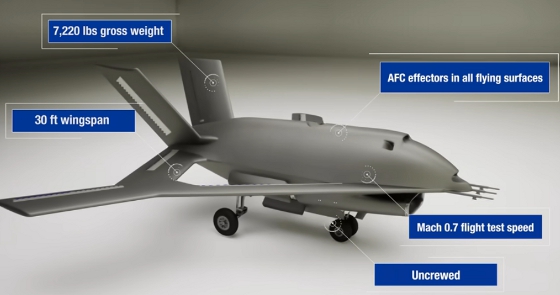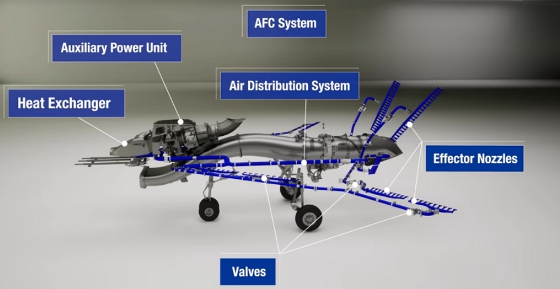 |
| March 12, 2024 | Volume 20 Issue 10 |
Designfax weekly eMagazine
Archives
Partners
Manufacturing Center
Product Spotlight
Modern Applications News
Metalworking Ideas For
Today's Job Shops
Tooling and Production
Strategies for large
metalworking plants
New X plane will test flying with no moving control surfaces

Aurora Flight Sciences will build DARPA's full-scale X-65 aircraft tech demonstrator that will feature no moving control surfaces. [Credit: DARPA/Aurora Flight Sciences]
DARPA has selected Aurora Flight Sciences, a Boeing company, to build a full-scale X-plane to demonstrate the viability of using active flow control (AFC) actuators for primary flight control. The award is Phase 3 of the Control of Revolutionary Aircraft with Novel Effectors (CRANE) program. This latest phase follows the successful completion of the critical design review (CDR) for the experimental aircraft, designated X-65. The aircraft is designed to demonstrate the benefits of AFC for both commercial and military applications.
In December 1903, the Wright brothers flew the world's first fully controllable aircraft, which used wing warping to successfully achieve flight. Virtually every aircraft since then has used a system of movable, external control surfaces for flight control.
The X-65 breaks this century-old design paradigm for flight control by using jets of air from a pressurized source to shape the flow of air over the aircraft surface, with AFC effectors on several surfaces to control the plane's roll, pitch, and yaw. Eliminating external moving parts is expected to reduce weight and complexity and improve performance.
"The X-65 is a technology demonstrator, and it's distinctive, diamond-like wing shape is designed to help us maximize what we can learn about AFC in full-scale, real-world tests," said Dr. Richard Wlezien, DARPA's program manager for CRANE.

The X-65 will be about the size of a military trainer aircraft. [Credit: Screenshot from Aurora Flight Sciences video]
X-65 is purpose-designed for testing and demonstrating AFC for multiple effects, including flight control at tactical speeds and performance enhancement across the flight envelope. The AFC system supplies pressurized air to 14 AFC effectors embedded across all flying surfaces, including multiple wing sweeps.
VIDEO: The X-65: Designed to demonstrate active flow control. See "under the hood." [Credit: Aurora Flight Sciences]
For testing comparisons, the X-65 will be built with two sets of control actuators: traditional flaps and rudders as well as AFC effectors embedded across all the lifting surfaces. The modular design features replaceable outboard wings and swappable AFC effectors, which allows for future testing of additional AFC designs. DARPA says this design will both minimize risk and maximize the program's insight into control effectiveness. The plane's performance with traditional control surfaces will serve as a baseline; successive tests will selectively lock down moving surfaces using AFC effectors instead.

The X-65 will feature 14 active flow control actuators, as well as a modular platform that will also test traditional control mechanisms. [Credit: Screenshot from Aurora Flight Sciences video]
"The X-65 conventional surfaces are like training wheels to help us understand how AFC can be used in place of traditional flaps and rudders," said Wlezien. "We'll have sensors in place to monitor how the AFC effectors' performance compares with traditional control mechanisms, and these data will help us better understand how AFC could revolutionize both military and commercial craft in the future."
The 7,220-lb, unmanned X-65 will have a 30-ft wingspan and be capable of speeds up to Mach 0.7 (about 540 mph). The designers say its weight, size, and speed -- similar to a military trainer aircraft -- will make the flight-test results immediately relevant to real-world aircraft design.
"We're building the X-65 as a modular platform -- wing sections and the AFC effectors can easily be swapped out -- to allow it to live on as a test asset for DARPA and other agencies long after CRANE concludes," said Wlezien.
Aurora Flight Sciences has already started fabricating the X-plane; the X-65 is scheduled to be rolled out in early 2025, with the first flight planned for summer of the same year. Component tooling and part fabrication are underway at Aurora facilities in West Virginia and Mississippi. Plans include building the airframe at Aurora West Virginia, followed by system integration and ground testing at Aurora's headquarters in Manassas, VA.
"As we move into the manufacturing phase, we are getting ever closer to fulfilling the goal of validating AFC technology and helping to open the design trade space for future applications," said Kevin Uleck, CRANE program director at Aurora Flight Sciences. "X-65 has the potential to change the future of aircraft design."
Sources: DARPA, Aurora Flight Sciences
Published March 2024
Rate this article
View our terms of use and privacy policy
